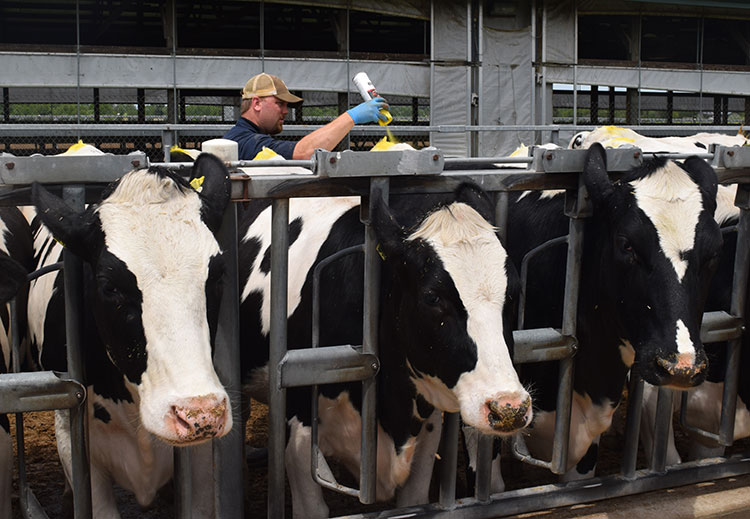
Heifers are the most fertile animals on any dairy. Yet, heifer rearing costs are often a dairy’s second largest expense.
The cost of rearing heifers increases as the days to first conception increases. By fine-tuning heifer reproduction programs, producers can save on feed and rearing costs, expedite breeding, and maximize genetic potential.
Health is first priority
First and foremost, heifers must be in good health and have a sound nutrition program to achieve the goal of freshening between 22 and 24 months of age (for Holstein herds). Healthy heifers grow faster, which leads to earlier breeding and joining the milking string faster, as long as maturity is adequate at calving.
Vaccination is also critical since it prepares heifers for breeding, reduces the risk of fertility problems and increases the chance of a healthy pregnancy. Work with your veterinarian to make vaccine selections that consider duration of immunity (DOI), which is the minimum duration you can expect a vaccine to protect against disease. Selecting vaccines with longer demonstrated protection helps safeguard pregnancies.
Customize breeding strategies
You can achieve excellent reproductive efficiency in heifers using both heat-detection-based programs and timed-A.I. (artificial insemination) protocols. However, all dairies should set goals, evaluate them regularly and make adjustments if goals are not met.
Pregnancy rate – or how quickly open heifers are brought into pregnancy – is a standard measurement of heifer reproduction. In heifer breeding programs, a common evaluation is percentage of heifers that are pregnant at 150 days from the start of breeding. Achieving a 90% pregnancy rate during this timeframe is exceptional.
Regarding timed-A.I. programs, a 2007 study used prostaglandin to induce estrus along with a heat-detection program. Prostaglandin was given every 11 days to more than 6,000 animals. By 22 days after the program’s start, 99% of the heifers were bred. Pregnancy rate was 70% by 22 days and by 60 days almost 90% of heifers were pregnant.
Relying on prostaglandin to achieve these types of results requires an accurate and efficient heat-detection program. You need to know the animals are responding and that the breeding technique is correct. A program that solely uses timed A.I. can submit heifers to first service in a narrow age range. Yet, this might not translate into increased profitability compared with programs that rely on heat detection to inseminate heifers.
The Dairy Cattle Reproduction Council has established breeding protocols that can be of assistance to dairies looking to develop or re-evaluate their current breeding program. Regardless of the chosen strategy, a large proportion of heifers should become pregnant on the first service while not extending age at first insemination.
Tips for better conception
No matter what type of program you use, there are ways to optimize conception rates.
Move heifers into the breeding pen as soon as they reach growth targets. The goal is to have 55% mature weight at breeding (~850 to 900 pounds). Heifers should be at least 85% mature weight post calving (~1,425 to 1,500 pounds). If heifers don’t meet this goal, they will continue to grow during their first lactation, which comes at the expense of milk production.
Administer prostaglandin as soon as heifers reach the breeding pen. Re-administer prostaglandin 10 to 12 days later for heifers not yet inseminated. This allows you to control breeding intervals and schedule entry of heifers into the milking herd. On average, it takes 12 days to first breeding. By using prostaglandin, days to first breeding will be reduced to approximately eight days.
Conduct timely pregnancy diagnosis. Confirm pregnant females as soon as possible so they can move out of the breeding pen and provide space for new heifers. All pregnancies should be reconfirmed between 70 and 90 days.
Be proactive with open heifers. Consider administering prostaglandin when a nonpregnancy diagnosis is given to induce estrus. Only use this strategy if efficient and accurate heat detection is possible.
Technology gives new answers
Cloprostenol sodium (Estrumate®) and dinoprost tromethamine (Lutalyse®) are the two primary prostaglandin products on the market. While they differ in chemical structure, both are designed to regress the corpus luteum and cause standing heat. Cloprostenol has a longer half-life than dinoprost and is maintained in circulation for a longer time. Does this make a difference in field conditions? Thanks to new technologies we are better able to answer this question.

Heifers given cloprostenol had lower progesterone concentration within 24 hours of onset of estrus versus heifers given dinoprost. The heifers with longer duration of estrus had higher conception rates. The study also found that heifers in a specific stage of the estrous cycle that were given dinoprost were less likely to be in heat versus heifers given cloprostenol.
As technologies continue to evolve, there’s even more opportunity to increase reproductive efficiencies in dairy heifers. The ability to reduce days on feed prior to first breeding is a huge advantage. To learn more about options for heifer synchronization and vaccination programs, consult your veterinarian.
IMPORTANT SAFETY INFORMATION FOR ESTUMATE: Women of childbearing age, asthmatics, and persons with respiratory problems should exercise extreme caution when handling Estrumate. Estrumate is readily absorbed through the skin and may cause abortion and/or bronchospasms; direct contact with the skin should be avoided and accidental spillage on the skin should be washed off immediately with soap and water. Do not administer Estrumate to a pregnant cow if abortion is not desired. Severe localized post-injection clostridial infections have been reported; in rare instances infection has led to death. At 50 and 100 times the recommended dose, mild side effects may be detected. For complete information on Estrumate, see package insert.



